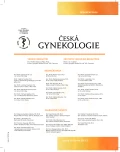HELLP syndrome requiring therapeutic plasma exchange due to progression to multiple organ dysfunction syndrome with predominant encephalopathy, respiratory and renal insufficiency
Authors:
M. Trávniková 1; J. Gumulec 3; Z. Kořístek 3; M. Navrátil 3; M. Janáč 4; J. Pelková 5; P. Šuráň 6; E. Doležálková 1; O. Šimetka 1,2
Authors‘ workplace:
Gynekologicko-porodnická klinika LF OU a FN, Ostrava, přednosta doc. MUDr. O. Šimetka, Ph. D., MBA
1; Lékařská fakulta OU, Ostrava
2; Klinika hematoonkologie FN, Ostrava, přednosta prof. MUDr. R. Hájek, CSc.
3; Gynekologicko-porodnické oddělení, Vsetínská nemocnice, a. s., primář MUDr. J. Hlavinka
4; Hematologicko-transfuzní oddělení, Vsetínská nemocnice, a. s., primářka MUDr. J. Pelková
5; Anesteziologicko-resuscitační oddělení, Vsetínská nemocnice, a. s., primář MUDr. M. Doležel
6
Published in:
Ceska Gynekol 2017; 82(3): 202-205
Overview
Objective:
Case report of woman with twin pregnancy complicated by HELLP syndrome which progressed to multiple organ dysfunction syndrome with predominant encephalopathy, renal and respiratory insufficiency with the need to perform repeated therapeutic plasma exchange.
Design:
Case report.
Setting:
Department of gynecology and obstetrics, University Hospital in Ostrava; Departmet of hematooncology, University Hospital in Ostrava; Department of gynecology and obstetrics, Vsetín hospital; Department of hematology and transfusion, Vsetín Hospital.
Results:
Case of 35-year-old III gravida/II para with previously normal ongoing twin bichorionic biamniotic pregnancy in week 35+0, which was admitted to secondary care delivery room for three days lasting “flu like” symptoms and the right upper quadrant pain. She was icteric, exhausted, but normotensive (120/75 mm Hg). Acute caesarean section was performed for suspected fetal hypoxia and HELLP syndrome. The laboratory exams confirmed coagulopathy and HELLP syndrome second class during the operation. Blood loss was 800 ml. Despite standard treatment of HELLP syndrome, the condition had developed to renal insufficiency, bilateral fluidothorax, alveolar pulmonary edema, encephalopathy and hypertension. In laboratory results dominates markers of coagulopathy, thrombocytopenia and microangiopathic hemolytic anemia with presence of schistocytes. Due to multiple organ dysfunction syndrome with hemolysis of unclear origin, patient was transferred to referral hospital on sixth postoperative day. Therapeutic plasma exchange (TPEX) was promptly begun. Improvement of laboratory parameters occurred already after the first TPEX and after two days there was a significant improvement of neurological status. Nine TPEX procedures were performed. The treatment was terminated after platelet count reached 100×109/l. She was discharged from hospital 21 days after delivery. After exclusion of other clinical entities, the case was closed as postpartum thrombotic microangiopathic syndrome.
Conclusion:
Postpartum thrombotic microangiopathic syndrome includes states, which resemble HELLP syndrome with their laboratory result and clinical expression, but their behavior is different – progressively worsening with signs of disseminated intravascular coagulation and complex microangiopathy with multiple organ dysfunction. It is not responding to classic treatment of HELLP syndrome. In this cases usually improvement of patients condition follow initiation of therapeutic plasma exchange.
Keywords:
postpartum thrombotic microangipathic syndrome, HELLP syndrome, plasmapheresis, hemolysis, encephalopathy, acute kidney injury, multiple organ dysfunction syndrom
Sources
1. Cho, FN., Chen, SN., Kan, YY., et al. Successful management of a pregnant woman with HELLP syndrome, pulmonary edema, postpartum hemorrhage and acute renal failure, using early hemodialysis, intravenous immunoglobulin and noninvasive monitoring: a case report. J Reprod Med, 2007, 52, 7, p. 661–663.
2. Čermáková, Z., Šimetka, O., Kořístka, M. Transfusion-related acute lung injury (TRALI) – review. Čes Gynek, 2013, 78, 2, s. 211–215.
3. Lampinen, K., Peltonen, S., Pettilä, V., et al. Treatment of postpartum thrombotic microangiopathy with plasma exchange using cryosupernatant as replacement. Acta Obstet Gynecol Scand, 2004, 83, 2, p. 175–179.
4. Martin, JN. Jr. Milestones in the quest for best management of patients with HELLP syndrome (microangiopathic hemolytic anemia, hepatic dysfunction, thrombocytopenia). Int J Gynaecol Obstet, 2013, 121, 3, p. 202–207.
5. Martin, JN. Jr., Files, JC., Blake, PG., et al. Plasma exchange for preeclampsia. I. Postpartum use for persistently severe preeclampsia-eclampsia with HELLP syndrome. Am J Obstet Gynecol, 1990, 162, 1, p. 126–137.
6. Mokrzycki, MH., Kaplan, AA. Therapeutic plasma exchange: complications and management. Am J Kidney Dis, 1994, 23, 6, p. 817–827.
7. Owens, MY., Martin, JN. Jr., Wallace, K., et al. Postpartum thrombotic microangiopathic syndrome. Transf Apher Sci, 2013, 48, 1, p. 51–57.
8. Šimetka, O., Klát, J., Gumulec, J., et al. Early identification of women with HELLP syndrome who need plasma exchange after delivery. Transfus Apher Sci, 2015, 52, 1, p. 54–59.
9. Šimetka, O. HELLP syndrom – diagnostika a léčba. Doporučený postup. Čes Gynek, 2014, 78, 3, s. 4.
Labels
Paediatric gynaecology Gynaecology and obstetrics Reproduction medicineArticle was published in
Czech Gynaecology

2017 Issue 3
Most read in this issue
- Complications tension-free vaginal tape surgery
- Current FIGO staging classification for cancer of ovary, fallopian tube and peritoneum
- Hirsutism
- Retrospective analysis of monochorionic twin pregnancies born in the Institute for the Care of Mother and Child between 2012–2015
